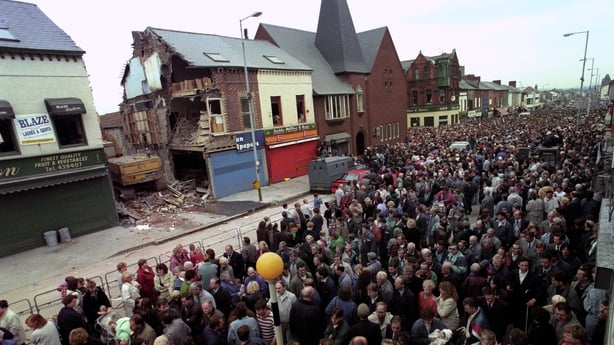Monday 23 October marks the 30th anniversary of the Shankill Road bombing.
The IRA no-warning bomb left in a fishmongers shop claimed the lives of nine innocent civilians, many were women and two were children out shopping on a busy street. It later emerged that the IRA bomber also died in the blast.
RTÉ's News Editor Roisin Duffy was the first reporter on the scene with RTÉ cameraman Johnny Coghlan, a veteran of the Troubles. Theirs were the first pictures seen around the world.
It was an atrocity that sparked a week of sectarian killings culminating in the Greysteel massacre at the Rising Sun bar in the Co Derry village of Greysteel.
In just seven days, 23 innocent civilians lost their lives to violence that has often been described as one of the darkest periods towards the end of the Troubles.
It was a grey Saturday morning - the sun would show its face later, only to illuminate one of the most horrific sights towards the end of the Troubles.
We were thinking of lunch as we drove back towards Belfast city centre. We were returning from an early morning story, a failed sectarian attack in north Belfast. There was an intern in the car and myself, the cameraman and the sound engineer were being grilled by our young apprentice.
As we drove through the roundabout at Carlisle Circus in the direction of the RTÉ office a fleet of police Land Rovers on high alert sped by. There was something about it. The cameraman noticed too - a look was exchanged through the rearview mirror.
I called the RUC press office; the familiar gravelly voice of an officer I had spoken to many times before answered. He said something had happened on the Shankill Road. He didn't know anything more, but it sounded bad. I handed our intern a tenner with instructions to go straight home.
Silence descended in the car, the silence that comes when you don’t know what you are driving into.
Halfway down the Shankill Road there was what looked like a large dust cloud. Mr Frizzell’s fish shop was sandwiched between two premises in a busy shopping precinct. The structure had collapsed. Now a pile of rubble and beams and masonry dust.
My first thoughts were please let this be a gas explosion and not a deliberately placed IRA bomb. There was chaos. People shouting, screaming, attempting to dig through the rubble for survivors with their bare hands.
We had arrived before the security cordon had been put in place.

The cameraman, Johnny Coghlan, a veteran of the no-warning bombs of the 1970s, instructed the sound engineer to stay in the car with the engine running. It was a dangerous time to have arrived. He told me people will think we are ghouls as we go about our job.
The camera was switched on but handheld - he never placed it on his shoulder. Instead my voice guided the direction of the lens. "Tilt up to the right," I whispered, as a stretcher bearing the body of a man, wearing the cap often worn by fishmongers, was brought out. It might have been the shop owner, John Frizzell, who died in the blast. "Pan left," I instructed, a man covered in dust, in complete shock, staring ahead.
A fleet of ambulances arrived, orders given, and then local people began to notice that we were The Press. Understandably abuse was shouted, ghouls indeed. In minutes we were back in the car, the rest of our footage filmed from afar.
Those were the pictures that the world saw.
30 years of 'sheer hell' since IRA's Shankill bomb
It was the beginning of the darkest period at the end of The Troubles. As night fell the loyalist paramilitary group the UFF issued a statement, all so called 'active service units' had been put on standby it said, the nationalist community would pay a heavy price.
Within hours reports came through that a Catholic delivery driver had been shot dropping off a Chinese takeaway at an address near the city centre. He died two days later.
The full horror of what had happened on the Shankill Road came the next morning with the list of the dead. Ordinary lives cut brutally short. Nine civilians died - among them 13-year-old Leanne Murray. She was one of two children killed that day. She’d left her mother’s side just moments before the blast.
Dazed, sitting in her home 24 hours later, her mother recounted how her life had been torn apart in a matter of two minutes . On hearing the blast, she and her partner Paul ran "screaming for Leanne, we couldn't find her, nobody knew where she was ... and she was underneath all that rubble," she said.
John Frizzell was described by a local woman as a "good living man" who played Christian music in his shop. His daughter also perished that day. A local clergyman talked of the slaughter of the innocents.
By the following weekend six more people had lost their lives in revenge sectarian attacks by the UVF and the UFF.

Again, it's the detail of the ordinary events of life, brutally interrupted, that remain 30 years later; Roisin Cairns eleventh birthday party had just finished. Her parents had left their house outside Lurgan to go to an Irish class. It was nearly Halloween. Two gunmen wearing masks came to the door, they brushed past the 11-year-old, she thought it was a prank. They went into the living room and shot her two brothers, Gerard and Rory dead at point blank range. The young girl had to run to the neighbours for help.
And then there was Greysteel, the massacre at the Rising Sun bar on the night before Halloween.
Eight more lives lost from both sides of the sectarian divide.
Seven days, 23 civilians dead - the slaughter of the innocent.


